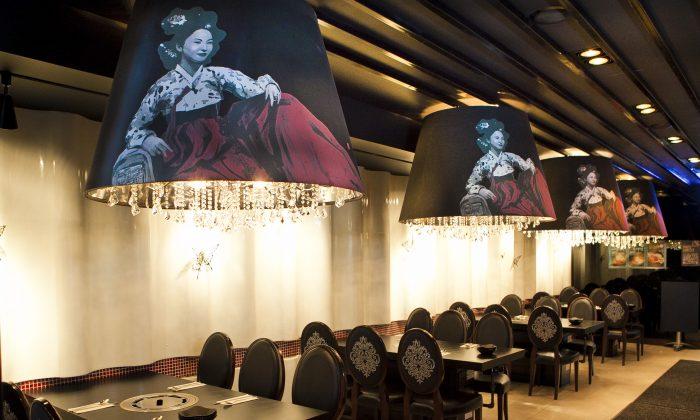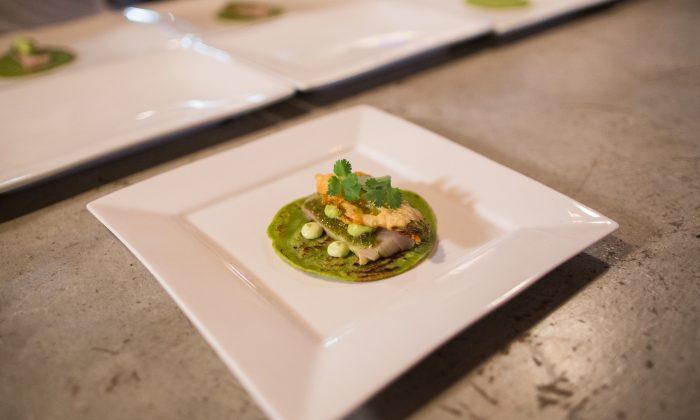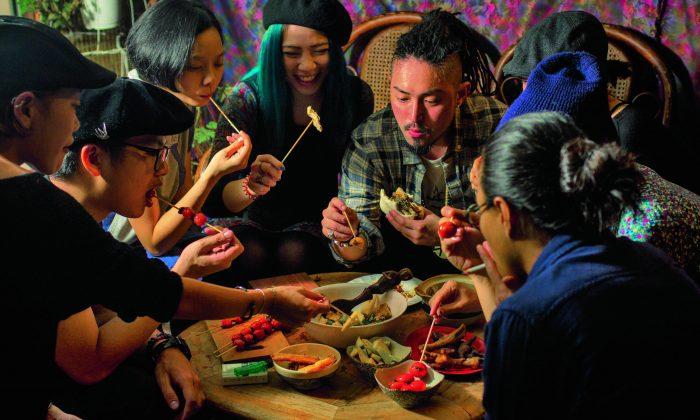It takes a good restaurant for New Yorkers to want to stand in line. Especially in Koreatown, which is chock-full of restaurants and eateries. Miss Korea is exceptional—on bustling 32nd Street it stands out among the masses and diners are happy to line up, especially on the weekends.
It’s a testament to how it distinguishes itself. For one, in a landscape where service is matter-of-fact, at best—here it is friendly and efficient (note the wireless headsets waitstaff wear for communication). The design, with a nod to nature as inspiration, makes for a pleasant, inviting retreat from the bustle of Midtown. While the cooking, also inspired by nature’s seasonality, takes a healthier approach than most.
For owner Sophia Lee, who was an elementary school teacher for 27 years before opening three successful restaurants in Manhattan and New Jersey, restaurants have always been a place for nourishment and relaxation. They were her refuge when she faced difficulties—surely enough good food, hospitality, and beautiful surroundings never failed to turn her mood around. These very elements make up the essence of miss Korea.
Three in One
Miss Korea feels more like three restaurants in one. The original miss Korea, on the first floor, “Jin,” or “The First,” has a trendy vibe with a nature-inspired aesthetic—from the use of stone walls with tufts of grass (the grass is artificial, but this is Manhattan, what do you expect?), to the muted mural of a forest on one wall, to the irregular, naturalistic edges of tables.
To the joy of people with irregular schedules, it is opened 24 hours a day, with a special late menu starting at 10:30 p.m.
It has been so successful that two more floors were added. The third one is a contemporary space, where shades of black and white with accents of red, pays homage to poet Hwang Jin Yi who was known for her poems about longing.
It’s not obvious at first, but the restaurant’s name miss Korea is not about any sort of pageantry, but rather a yearning and nostalgia for Korea.
“The Second” floor, “Sun,” is an oasis of calm, inspired by Korea’s Joseon Dynasty (1392–1910). The aesthetic is spare and beautiful, with light wood and warm lighting throughout, and it’s adorned with delicate details and Korean artwork.
Peaceful private rooms, accommodating parties of eight or more, were inspired by the Korean sarangbang. In historical times, these traditional study rooms, where one could practice writing, calligraphy, and painting, also doubled as places where nobles would engage in discussion of politics and culture, over tea. In a sense they were cradles for reflection, interaction, and new ideas.
The rooms at miss Korea are especially sought after by business people looking for a quiet, classy space away from prying eyes and ears, but even families will appreciate the serene environment.
The rhythm of agrarian and natural life is on display, with seasonal landscapes gracing the walls, mingling with illustrations from well-known Korean stories.
Details are carefully tended to, even the tableware. Brassware bowls and chopsticks are the norm here. They are valued for their insulating properties, but difficult to maintain (the onerous group task of polishing takes place once a month).
A Healthier Cuisine
Looking back at my first introduction to Korean food, I remember it was delicious, but definitely more than my day’s share of sodium and sugar.
Miss Korea has a much more restrained flavor profile. It’s out of consideration to diners’ health, but in truth, it makes it easier to appreciate the wide range of flavors in the dishes. It is just as satisfying, if not more so.
The banchan alone, with its multiple palate-whetting small dishes (nine for lunch, eight for dinner, all included in the price of the entrée) take you on a journey between the astonishing sweetness of different greens and the earthiness and tanginess that can only be coaxed out through an alchemy of fermentation. Between the homemade kimchi, sweet-spicy radishes, tender caramelized yams, and crunchy soybean sprouts, I could have been quite happy munching on those alone; but of course, they were just the beginning.
To create the menu, Sophia Lee called on the services of Sun Kyu Lee who is a renowned food consultant in South Korea.
I opted for a five-course dinner menu served on the second floor (available for $49.95, $59.95, or $69.95 for dinner; lunch for $24.95). There are more affordable options as well, including lunch specials, ranging from $8.95 for kimchi jigae, a spicy kimchi stew with pork, tofu, and vegetables, to $16.95 for barbecued galbisal, marinated boneless short ribs.
In winter, the seasonal course menu offers warmth and deep flavors, worth coming out of hibernation for a couple of hours.
To start out, a small bowl of comforting porridge (the day’s offering was a delicious crabmeat porridge), dried fruit and vegetable chips (made in-house, daily), three pancakes (kimchi, mushroom, and mung bean), and a fresh house salad.
The banchan is plentiful and delicious, varied, and bright—perfect as palate openers.
Probably the best dish for a winter’s day was the kalbi jjim, a stew of boneless short ribs served with sautéed golden needles, potatoes, rice cakes (not the crumbly dieting kind mind you, but dense, chewy little slices made of rice flour), and jujube strands. Another entree included a sauteed red snapper, with golden mushrooms, and nutty-sweet-starchy lotus root.
Miss Korea’s signature dish is the clay pot galbi, marinated for 48 hours in onggi, Korean ethnic earthenware. In ancient times, these were believed to be breathing vessels, and indeed magnification reveals pores small enough to let air circulate. According to the website, the two-day process allows for better texture and flavor.
While the marinated beef doesn’t need anything but a dab of soybean sauce (also lighter in comparison to most places), some rice, and the whole carried through on a fresh lettuce leaf, unmarinated beef can be painted over with a bit of a simple sauce of sesame salt and oil.
If ancient tradition has its place at the table at miss Korea, so does cutting-edge technology. The infrared grills at the table (the first on the East Coast) make for quicker cooking and are smokeless. It was the first time since I’ve been at a Korean restaurant that neither my clothes nor my hair would reveal that I had been eating Korean barbecue.
After barbecue dishes, mul naengmyeon, a cold buckwheat noodle soup is perfect. With delicate thin slices of cucumber and Asian pear, it is surprisingly refreshing—a fitting ending to a couple of hours spent in the peaceful refuge that is miss Korea.
miss Korea BBQ
10 West 32nd St.
www.misskoreabbq.com
miss KOREA JIN the First
212-594-4963
Open 24 hours a day, 7 days a week
miss Korea SUN The Second
212-736-3232
Hours
Sunday–Wednesday 11 a.m.–10 p.m.
Thursday–Saturday 11 a.m.–midnight





